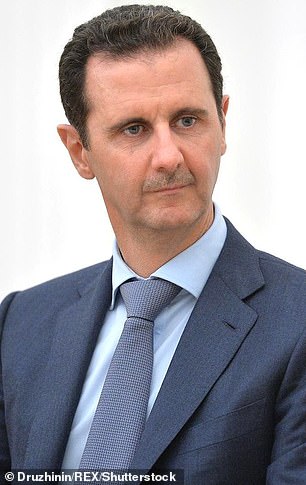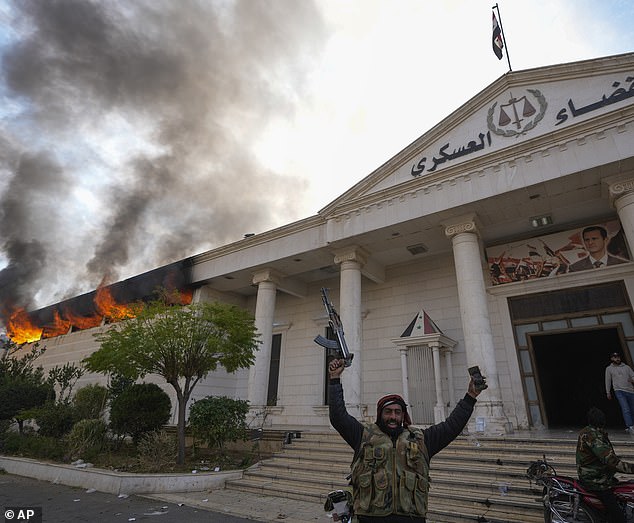When I arrived in Damascus 35 years ago, on my first visit as a foreign correspondent, I expected to find a gray swamp of dictatorial repression.
After all, this was a country under the tight control of despot Hafez al-Assad, who, just seven years earlier, had massacred 20,000 of his people while crushing an Islamist uprising in the city of Hama.
Instead, I found a capital that, at first glance, seemed colorful and quite relaxed. The restaurants and cafes were full and the customers were happy.
Mosques and Christian churches stood side by side, and the old city’s antique shops were mostly owned by Jews, an echo of the country’s long phases of religious coexistence.
True, Assad’s hatchet face shone from billboards everywhere. But the rule seemed to be that citizens who did not raise their voices against the leader – the so-called “Lion of Damascus” – would be allowed some personal freedom.
When his son Bashar succeeded him in 2000, there were hopes that the shy and quiet London-trained ophthalmologist could usher in a measure of liberalisation. And so it seemed for a while, with cautious signals from the regime that reform was in the air.
But the Damascus Spring was short-lived. In 2011, Bashar’s forces acted with unrestrained brutality to suppress protesters calling for an end to the tyranny of the Assad clan, killing at least 5,000 protesters and dissidents in one year.
It was the beginning of a civil war in which Bashar proved to be as ruthless and bloodthirsty as his father. Murder, torture, rape, mass imprisonment, and military raids showing a bloody disregard for civilian life kept him in power, aided and abetted by his fellow despots in Moscow and Tehran.
Opposition fighters celebrate as they burn down a military court in Damascus.
The damage caused to the country is indescribable. Cities and towns are in ruins; 600,000 Syrians have died – half of them civilians; More than 13 million people have fled their homes. No wonder, then, that the escape of the loathsome Bashar has been greeted with great joy.
Commentators have been quick to pour cold water on naïve assumptions that the country’s nightmare is over.
They point to similar scenes of ecstasy after the fall of Saddam Hussein in Iraq in 2003, and of Muammar Gaddafi in Libya eight years later. Both countries quickly collapsed into factional fighting, violence and anarchy.
Former MI6 chief Sir Alex Younger yesterday warned that what comes next is likely to be “a resurgence of civil war and conflict in all its dimensions”.
Rightly we should be very cautious. Half a century of dictatorship has brutalized important sectors of the population and fragmented social cohesion. Black pessimism is rarely unfounded when considering events in the Middle East.
However, as the dust settles, I think we can glimpse some signs of hope. Syria is not Iraq. There, the United States imposed regime change, without any national construction plan or internal opposition capable of implementing it.
The Syrian insurgency is of local origin. It may have been sustained by external powers and contain elements that are rightly alarming to the West. However, its basic agenda – ousting Assad – was simple and difficult to accept.
The rebels may be Islamists, but they are also nationalists who say they want to heal Syria and make it work.


After the fall of Assad (right), Donald Trump would do well to reconsider his thinking that “this is not our fight”, writes PATRICK BISHOP
The big question is what will happen when the euphoria wears off; and here, again, there are reasons to allow ourselves a little optimism.
So far, the main rebel group Hayat Tahrir-al Sham (HTS) has proven disciplined, effective and politically adept. So far, there has been nothing of the magnitude of the savage looting that we saw after the fall of the Iraqi cities of Basra and Baghdad in 2003. However, the group has caused alarm in some quarters, not least because of the support it has garnered. of Hamas Terrorists in Gaza.
But HTS leader and, at least for now, Syria’s de facto ruler, Abu Mohammed al-Jolani, seems determined not to scare the horses. He has done his best to soften the image of both himself and HTS, ditching his jihadist garb for a jacket and an open-necked shirt for some media encounters.
He is a casting director’s dream of an Arab rebel sheikh: handsome, noble in bearing, and with a hint of twinkle in his brown eyes.
His script for the future, as he put it in a CNN interview last week, could have come from the lips of Nelson Mandela. He acknowledged his troubled past as ’emir’ of the Syrian branch of Al Qaeda, but claimed that time had calmed him down.
“A 20-year-old will have a different personality than someone who is 30 or 40,” said the 45-year-old.
The emphasis is on building strong state institutions and uniting the country with equal rights for all citizens, regardless of their sect or clan.
In an attempt to win Western support, Jolani has cleverly argued that Assad’s fall is a victory for everyone except Russia and Iran. It emphasizes that a peaceful Syria could reverse immigration flows and bring back refugees from Türkiye, Lebanon, Jordan and Europe, including Britain.
It is one of several powerful arguments that should prompt the West to act quickly to stabilize the situation. Donald Trump, in particular, would do well to reconsider his thoughts that “this is not our fight” and “America should have nothing to do with it.”
It is unlikely to be the president-elect’s last word on the matter since, during his last term, his policy toward Syria swung sharply from withdrawal to engagement and back again. The truth is that the United States – and the rest of us – have a whole pack of dogs in this fight.
On the one hand, the Islamic State jihadists, who once plunged swaths of the region into medieval barbarism, are under control for the moment: many of them caged in detention camps run by Syrian Kurds with the support of some 1,000 soldiers. Americans.
But if Trump were to order Americans to return home, IS hardliners could well break loose to regroup and resume their campaign of terror.
But there is something even bigger at stake. The power vacuum left by Assad’s flight has presented Trump and the West with a golden opportunity.
A stable Syria is in the interest of every well-intentioned power. With Iran deflated and Russia weak from repeated humiliations in both Syria and Ukraine, there is an opportunity here to replace their malign meddling with positive support.
With practical help from the United States and Europe, homes can be rebuilt and refugees repatriated. This could be the beginning of a positive partnership with Damascus, which could begin to heal the deep wounds of the past.
Trump’s “America First” doctrine clashes with his desire to see his name etched in history. In time, Syria could become the cornerstone of a broader Middle East peace, based on the 2020 Abraham Accords launched during Trump’s first presidency. This began the process of normalizing relations between two of the Gulf States with Israel, only to be derailed by the massacre of October 7 last year.
Although recent history may suggest otherwise, Syria is not doomed to endure endless inter-communal conflicts. The Damascus of mixed mosques and churches that I saw in 1989 was not a mirage but an echo of a long, if intermittent, past of harmonious coexistence.
Events have now conspired to offer hope that Syrians can live it again.
- Patrick Bishop is a former Middle East correspondent and co-host of the Battleground podcast with historian Saul David.

